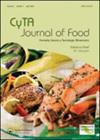Evaluation of phytonutrients composition and nutraceutical potential of tomato by-products
IF 1.7
4区 农林科学
引用次数: 0
Abstract
ABSTRACT This study aims to evaluate the phytonutrient composition, antioxidant activity and nutraceutical potential of peels and seeds of two tomato cultivars. Levels of phytonutrients such as phenolic compounds, carotenoids, chlorophyll, salicylic acid and vitamin C were assessed. Potential in vitro antioxidant activities were evaluated. Tomato has quite interesting levels of phenolic compounds such as total phenols and flavonoids, whose contents varied from 78.41 ± 1.52 to 272.17 ± 53 mg GAE/100 g DM and 13.35 to 139.89 mg QE/100 g DM, respectively. They also contained chlorophyll, which was concentrated in the peels (39 to 78 mg/100 g DM). β-carotene and lycopene contents ranged from 4.63 to 105 mg/100 g DM and 7.51 to 32.45 mg/100 g DM, respectively. Vitamin C level was high in peels with an average content of 27.82 mg/100 g DM. Tomato by-products showed high antioxidant activity with 61% DPPH inhibition and 108.55 to 120.86 µg EAA/g with FRAP method. With this richness in phytonutrients and their strong antioxidant power, tomato by-products have important nutraceutical potentials to be valorized with in vivo experiments.番茄副产品的植物营养成分和营养潜力评价
摘要本研究旨在评价两种番茄品种果皮和种子的植物营养素组成、抗氧化活性和营养保健潜力。评估了植物营养素如酚类化合物、类胡萝卜素、叶绿素、水杨酸和维生素C的水平。对其体外抗氧化活性进行了评价。番茄中总酚和总黄酮的含量分别为78.41±1.52 ~ 272.17±53 mg GAE/100 g DM和13.35 ~ 139.89 mg QE/100 g DM。它们还含有叶绿素,叶绿素集中在果皮中(39 ~ 78 mg/100 g DM)。β-胡萝卜素和番茄红素含量分别为4.63 ~ 105 mg/100 g DM和7.51 ~ 32.45 mg/100 g DM。果皮中维生素C含量较高,平均含量为27.82 mg/100 g DM。番茄副产物具有较高的抗氧化活性,DPPH抑制率为61%,FRAP法测定的EAA含量为108.55 ~ 120.86µg /g。番茄副产品富含丰富的植物营养素和强大的抗氧化能力,具有重要的营养保健潜力,可以通过体内实验进行验证。
本文章由计算机程序翻译,如有差异,请以英文原文为准。
求助全文
约1分钟内获得全文
求助全文
来源期刊

Cyta-Journal of Food
FOOD SCIENCE & TECHNOLOGY-
CiteScore
4.40
自引率
0.00%
发文量
37
期刊介绍:
CyTA – Journal of Food is an Open Access journal that publishes original peer-reviewed research papers dealing with a wide range of subjects which are essential to the food scientist and technologist. Topics include: chemical analysis of food; additives and toxins in food; sensory, nutritional and physiological aspects of food; food microbiology and biotechnology; changes during the processing and storage of foods; effect of the use of agrochemicals in foods; quality control in food; and food engineering and technology.
 求助内容:
求助内容: 应助结果提醒方式:
应助结果提醒方式:


